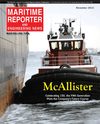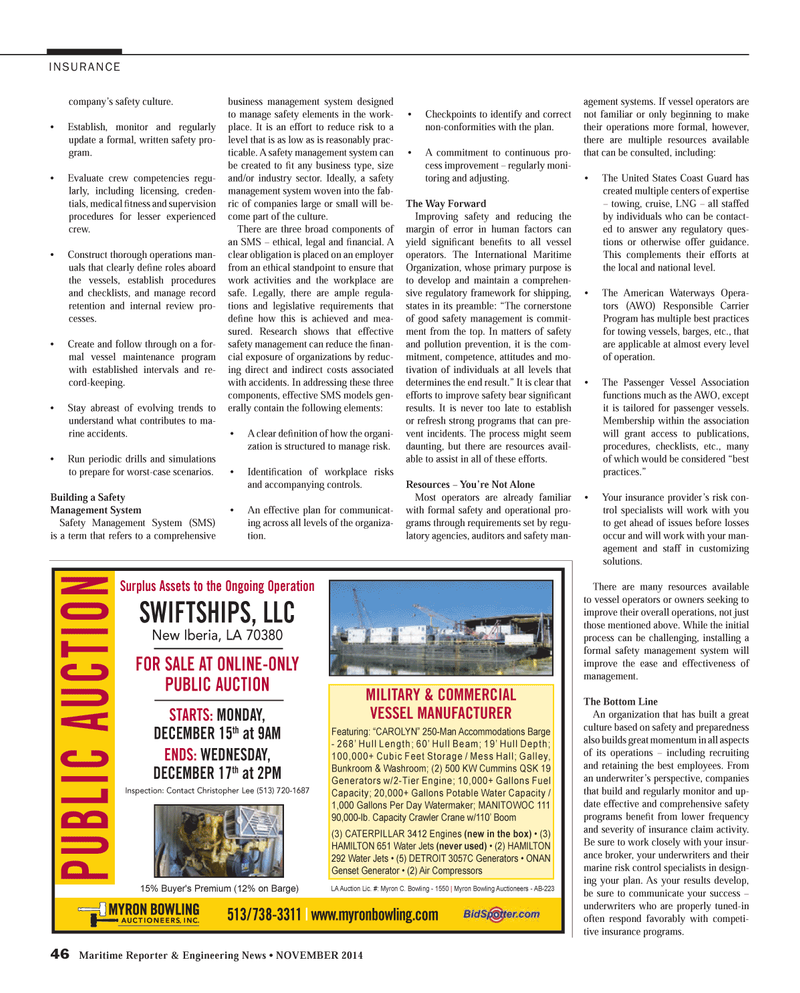
Page 46: of Maritime Reporter Magazine (November 2014)
Workboat Edition
Read this page in Pdf, Flash or Html5 edition of November 2014 Maritime Reporter Magazine
46 Maritime Reporter & Engineering News • NOVEMBER 2014 company’s safety culture. • Establish, monitor and regularly update a formal, written safety pro- gram. • Evaluate crew competencies regu- larly, including licensing, creden- tials, medical ? tness and supervision procedures for lesser experienced crew. • Construct thorough operations man- uals that clearly de? ne roles aboard the vessels, establish procedures and checklists, and manage record retention and internal review pro- cesses. • Create and follow through on a for- mal vessel maintenance program with established intervals and re- cord-keeping. • Stay abreast of evolving trends to understand what contributes to ma- rine accidents. • Run periodic drills and simulations to prepare for worst-case scenarios.
Building a Safety
Management System
Safety Management System (SMS) is a term that refers to a comprehensive business management system designed to manage safety elements in the work- place. It is an effort to reduce risk to a level that is as low as is reasonably prac- ticable. A safety management system can be created to ? t any business type, size and/or industry sector. Ideally, a safety management system woven into the fab- ric of companies large or small will be- come part of the culture.
There are three broad components of an SMS – ethical, legal and ? nancial. A clear obligation is placed on an employer from an ethical standpoint to ensure that work activities and the workplace are safe. Legally, there are ample regula- tions and legislative requirements that de? ne how this is achieved and mea- sured. Research shows that effective safety management can reduce the ? nan- cial exposure of organizations by reduc- ing direct and indirect costs associated with accidents. In addressing these three components, effective SMS models gen- erally contain the following elements: • A clear de? nition of how the organi- zation is structured to manage risk. • Identi? cation of workplace risks and accompanying controls. • An effective plan for communicat- ing across all levels of the organiza- tion. • Checkpoints to identify and correct non-conformities with the plan. • A commitment to continuous pro- cess improvement – regularly moni- toring and adjusting.
The Way Forward
Improving safety and reducing the margin of error in human factors can yield signi? cant bene? ts to all vessel operators. The International Maritime
Organization, whose primary purpose is to develop and maintain a comprehen- sive regulatory framework for shipping, states in its preamble: “The cornerstone of good safety management is commit- ment from the top. In matters of safety and pollution prevention, it is the com- mitment, competence, attitudes and mo- tivation of individuals at all levels that determines the end result.” It is clear that efforts to improve safety bear signi? cant results. It is never too late to establish or refresh strong programs that can pre- vent incidents. The process might seem daunting, but there are resources avail- able to assist in all of these efforts.
Resources – You’re Not Alone
Most operators are already familiar with formal safety and operational pro- grams through requirements set by regu- latory agencies, auditors and safety man- agement systems. If vessel operators are not familiar or only beginning to make their operations more formal, however, there are multiple resources available that can be consulted, including: • The United States Coast Guard has created multiple centers of expertise – towing, cruise, LNG – all staffed by individuals who can be contact- ed to answer any regulatory ques- tions or otherwise offer guidance.
This complements their efforts at the local and national level. • The American Waterways Opera- tors (AWO) Responsible Carrier
Program has multiple best practices for towing vessels, barges, etc., that are applicable at almost every level of operation. • The Passenger Vessel Association functions much as the AWO, except it is tailored for passenger vessels.
Membership within the association will grant access to publications, procedures, checklists, etc., many of which would be considered “best practices.” • Your insurance provider’s risk con- trol specialists will work with you to get ahead of issues before losses occur and will work with your man- agement and staff in customizing solutions.
There are many resources available to vessel operators or owners seeking to improve their overall operations, not just those mentioned above. While the initial process can be challenging, installing a formal safety management system will improve the ease and effectiveness of management.
The Bottom Line
An organization that has built a great culture based on safety and preparedness also builds great momentum in all aspects of its operations – including recruiting and retaining the best employees. From an underwriter’s perspective, companies that build and regularly monitor and up- date effective and comprehensive safety programs bene? t from lower frequency and severity of insurance claim activity.
Be sure to work closely with your insur- ance broker, your underwriters and their marine risk control specialists in design- ing your plan. As your results develop, be sure to communicate your success – underwriters who are properly tuned-in often respond favorably with competi- tive insurance programs.
INSURANCE
MILITARY & COMMERCIAL
VESSEL MANUFACTURER
Featuring: “CAROLYN” 250-Man Accommodations Barge - 268’ Hull Length; 60’ Hull Beam; 19’ Hull Depth; 100,000+ Cubic Feet Storage / Mess Hall; Galley,
Bunkroom & Washroom; (2) 500 KW Cummins QSK 19
Generators w/2-Tier Engine; 10,000+ Gallons Fuel
Capacity; 20,000+ Gallons Potable Water Capacity / 1,000 Gallons Per Day Watermaker; MANITOWOC 111 90,000-lb. Capacity Crawler Crane w/110’ Boom (3) CATERPILLAR 3412 Engines (new in the box) • (3)
HAMILTON 651 Water Jets (never used) • (2) HAMILTON 292 Water Jets • (5) DETROIT 3057C Generators • ONAN
Genset Generator • (2) Air Compressors
Surplus Assets to the Ongoing Operation
SWIFTSHIPS, LLC
New Iberia, LA 70380
FOR SALE AT ONLINE-ONLY
PUBLIC AUCTION
STARTS: MONDAY,
DECEMBER 15 th at 9AM
ENDS: WEDNESDAY,
DECEMBER 17 th at 2PM
Inspection: Contact Christopher Lee (513) 720-1687 513/738-3311 | www.myronbowling.com
PUBLIC AUCTION 15% Buyer's Premium (12% on Barge) LA Auction Lic. #: Myron C. Bowling - 1550 | Myron Bowling Auctioneers - AB-223
MR #11 (42-49).indd 46 11/5/2014 10:48:14 AM

 45
45

 47
47
